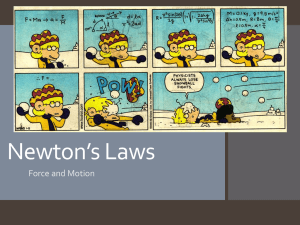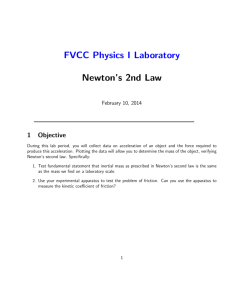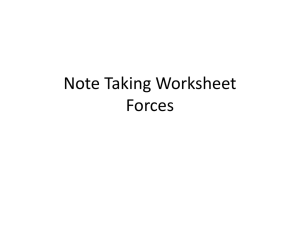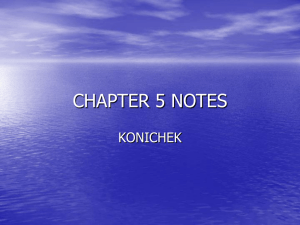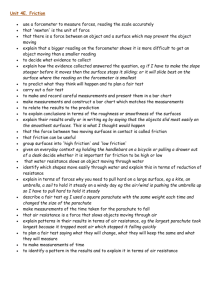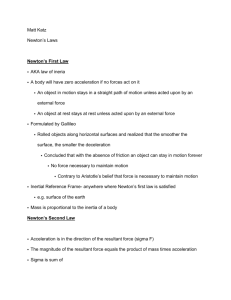Chapter 11 Science Notes
advertisement
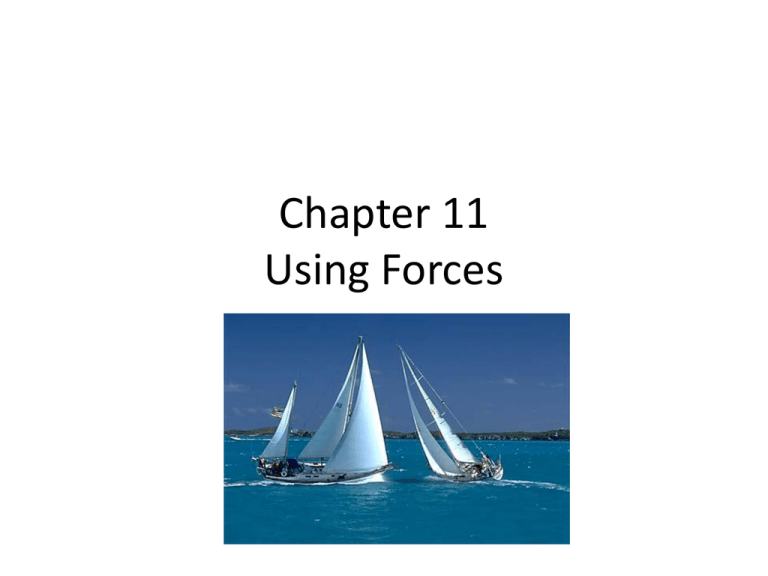
Chapter 11 Using Forces Lesson 1 Motion • • Position- the location of an object. It answers the question, “Where is the object?” Motion- a change in position over time. Motion has two parts: distance and direction Distance can be measured by using arrows on a grid and a ruler. ***Units of measurement for distance: meters(m), kilometers(km), feet(ft), or miles(mi) Direction is where an arrow is pointing: north, south, east, west (use a compass, protractor, and units of degrees) Lesson 1 continued… • Speed- how fast an object’s position changes over time. To calculate speed: Speed=distance ÷ time Lesson 1 continued… • Velocity- measurement that combines both the speed and direction of a moving object. • Acceleration- change in velocity over time for an object Acceleration=change in speed ÷ time • Momentum- the more momentum an object has, the easier it is for that object to move other objects. Momentum= mass x velocity Lesson 2 Forces and Motion • Force- any push or pull from one object to another Forces can crush, stretch, or twist objects and deform them. (you can crush an aluminum can with your hands) The harder the substance is, the more force it takes to change its shape. Lesson 2 Continued… • Friction- The force that opposes the motion of one object moving past another Friction depends on the surfaces of two objects and how hard the objects are pushed together. ***smooth surfaces=less friction ***rough surfaces=more friction Friction also increases with the weigh of the object • Air resistance- When an object moves through air, the air hits an object and slows it down. Lesson 2 Continued…. Newton’s First Law of Motion An object at rest tends to stay at rest, and an object in constant motion tends to stay in motion, unless acted upon by an outside force Newton’s First Law of Motion is sometimes called the law of inertia • Balanced forces- when forces act on an object without changing its motion Lesson 2 continued…. Newton’s Second Law of Motion The unbalanced force of an object is equal to the mass of the object multiplied by its acceleration: Force= mass x acceleration Lesson 2 Continued… Newton’s Third Law of Motion All forces occur in pairs, and these two forces are equal in strength and opposite in direction. For every action there is an equal and opposite reaction! • Action Forces- the push of the first object on the second object. • Reaction Forces- the push of the second object back on the first. Lesson 3 Work and Energy • Work- measurement of the energy used to perform a task Work= force x distance Friction Pulling force • Energy- the ability to perform work or to change an object Lesson 3 continued… • Potential Energy- energy that is stored in the position or structure of an object • Kinetic Energy- energy of a moving object • Law of Conservation of Energy- energy cannot be created or destroyed it can only change form. Potential Energy (stored energy) Kinetic Energy (releasing energy) Lesson 4 Simple Machines • Simple Machines- a machine that takes one force and changes its direction, distance, or strength. • Effort- the force you apply to a machine • Load- the object moved by the output • Fulcrum- a lever that rotates around a pivot point Fulcrum Lesson 4 continued… • • • • Gears are a type of wheel and axle A winding road is a type of inclined plane A screw is an inclined plane wrapped around a post Scissors, knives, and other cutting tools take advantage of the wedge. Lesson 4 continued… • Compound Machines- when two or more simple machines are combined • Efficiency – ratio of input energy to output work, usually written as a percentage. A bike is made up of many simple machines, so it is considered a compound machine
